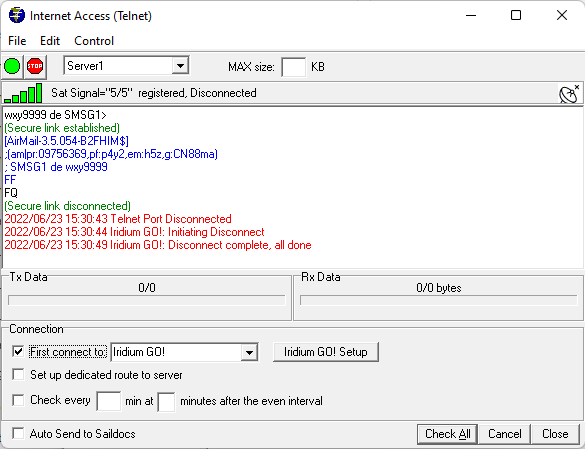If your sending speeds are consistently slow then there is something wrong on the transmit-side of your equipment– an incorrect setting, a problem with the radio itself, or perhaps a problem with the tuner or antenna. Check your equipment carefully, or find a qualified radio technician to help (and have him read this also). In order to send at optimum speed your needs to be transmitting full power (or some reasonable fraction) and the antenna must be working efficiently.
Start with the radio power-settings and make sure that your radio is set to hi-power mode, power-level “3” for an Icom-M710. (Note that these comments are general but include some specific details for the Icom M710, other radios will vary). One of the myths is that low-power works just as well, this is only true when the station is relatively close- and definitely NOT the case from the middle of the South Pacific.
Next check the tuner connections- make sure that the ground and antenna connections are clean and tight. It is a good practice to remove, clean, and reconnect these connections every year or so, and make sure they are protected from the weather. Also make sure that the wire from tuner to antenna is as short as possible and spaced away from other wiring and metal by at least 2-3″, do not strap this wire into a harness bundle or to the lower backstay for example.
Next check the tuner function: Most marine radio’s have a “TUNE” indicator which indicates when the tuner is active, and when it has properly tuned. For an M710 and M802 radios the “TUNE” indicator on the display will flash for a few seconds when first transmitting as the radio completes its auto-tune cycle, then “TUNE” will remain ON steady. If “TUNE” flashes and goes off then the tune-cycle failed, and the radio will be transmitting very inefficiently and only with a few watts. This is either a tuner problem, or a problem with the control-cable, or a corroded antenna or ground connection.
Next check the transmit power-output. Most radios have a power-output indicator, the M710 has a “bar-graph” of 8 segments. For a M710 the power-out indicator should indicate 7 bars on steadily when calling the station, with the 8th bar (above the “SQL” label) flickering). (You can initiate FSK-transmission with Airmail’s “Set-PTC Aplitude” control, under the Control menu on Terminal window).
If you have a battery monitor which shows DC amps used from the battery, then another good way to check transmit-power is to check the INCREASE in DC amps while transmitting (with battery-charger OFF). For an M710 or M802 this should be 8-14 amps, 100W radios will be a bit lower. For example, if the battery-monitor shows 5 amps when listening, then it should show about 15 amps (a 10-amp increase) when the radio is transmitting.
If the transmit power is low, then this likely indicates that the “FSK” and “PSK” amplitude settings in Airmail are not correct for your radio. (These settings control the modem’s audio “volume” control for the signal sent to the radio, and this in turn controls the transmit-power. The FSK setting is used for calling, PSK once connected. PSK should always be about 30% higher than FSK).
Open Airmail’s Tools/Options menu, connection tab, and check these settings in the lower-right. (You can also access these settings when Terminal-window is open, via Control/Set PTC amplitude menu). Older Icom M710’s are usually 140/170 for FSK/PSK, newer M710’s and M802’s are usually 250/330, systems which Marc Robinson set up usually have special cables and are set to 600/1000, Furuno radios are usually 1500/2000.
If increasing the FSK/PSK levels does not increase transmit power then the radio may be set to low-power mode (see above), or there may be a failure in the radio’s power-output transistors. You can verify the transmit function independently of the modem by finding an unused voice-frequency (e.g. 12,359.0) and whistling into the mic while watching the power-out indicator and/or battery-monitor. You should be able to reach full-power output no problem.
If problems persist then Sailmail members should write to sysop@sailmail.com with as many details as possible.
Good sailing,
Sue & Jim

